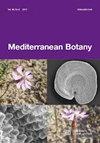Quantitative ethnobotanical investigation of medicinal plants used by local population in the rural municipalities of Haizer and El Asnam, province of Bouira, Northern Algeria
IF 0.7
4区 生物学
Q3 PLANT SCIENCES
引用次数: 1
Abstract
This study aims to assess ethnobotanical knowledge in Kabylia, focusing on the traditional uses of medicinal plants. The purpose was to quantify the traditional knowledge of medicinal plants commonly used by local populations for treating a wide range of ailments, with a view to preserve the medicinal knowledge and the biodiversity of this area. Ethnobotanical data was gathered using a questionnaire. Semi-structured interviews were conducted with 69 key informants at six villages of Bouira province. A quantitative analysis by means of different indices including the informant consensus factor (FIC), use value (UV), relative frequencies of citation (RFC), and fidelity level (FL), was performed for the recorded medicinal plants. Overall, 136 plants species were recorded. Their uses in 10 disease categories were documented. They belong to 54 families, the most represented are the Asteraceae (18 species) and Lamiaceae (16 species). With 98 use reports, diabetes is the most treated ailment. The highest RFC values are recorded for Carthamus caeruleus (0.57) and Asplenium ceterach (0.52), indicating that these plants are the most preferred species used in study areas, to treat skin burns and kidney stones respectively. Plant with the highest use value is Lavandula stoechas (1.21), used to treat different digestive disorders (bloating, colon pain, and stomach ulcer). We found 13 medicinal plants having the highest FL value (100%), e.g. Rhamnus alaternus (jaundice), Lonicera implexa (weak eyesight), and Ulmus minor for treating skeletomuscular ailments. These latter are the most interesting species used in the treatment of a specific ailment category. The maximum FIC value (0.86) indicated that there was high agreement in the use of plants (e.g. Aristolochia fontanesii and Ophrys speculum) in genitourinary and reproductive ailment category among the informants. We highlighted the homogeneity of informant knowledge in medicinal plants appropriate for different ailment categories and the most preferred plant species used to treat each ailment category in the study area. By overstepping the limits of an orally transmitted pharmacopoeia, we aim to valorize the huge ethnopharmacology legacy of the region for promising pharmacological perspectives.阿尔及利亚北部布伊拉省Haizer和El Asnam农村地区当地居民使用的药用植物的定量民族植物学调查
本研究旨在评估Kabylia的民族植物学知识,重点关注药用植物的传统用途。其目的是量化当地居民通常用于治疗各种疾病的药用植物的传统知识,以期保护该地区的药用知识和生物多样性。民族植物学数据是通过问卷调查收集的。对布伊拉省6个村庄的69名关键线人进行了半结构化访谈。采用信息者共识因子(FIC)、使用价值(UV)、相对被引频次(RFC)和保真度(FL)等指标对所记录的药用植物进行定量分析。共录得136种植物。记录了它们在10种疾病类别中的用途。它们分属54科,最具代表性的是菊科(18种)和Lamiaceae(16种)。在98份使用报告中,糖尿病是治疗最多的疾病。红花(Carthamus caeruleus)和石笋(Asplenium ceterach)的RFC值最高,分别为0.57和0.52,表明这两种植物是研究地区治疗皮肤烧伤和肾结石的首选植物。使用价值最高的植物是Lavandula stoechas(1.21),用于治疗不同的消化系统疾病(腹胀、结肠疼痛和胃溃疡)。我们发现有13种药用植物的FL值最高(100%),如鼠李(黄疸),金银花(弱视)和小榆(骨骼肌疾病)。后者是用于治疗特定疾病类别的最有趣的物种。最大FIC值(0.86)表明,在泌尿生殖系统和生殖疾病类别中,告密者对植物(如马兜铃和蕨)的使用有很高的一致性。我们强调了不同疾病类别的药用植物知识的同质性,以及研究区域中用于治疗每种疾病类别的最首选植物物种。通过超越口头传播药典的限制,我们的目标是为有希望的药理学观点评估该地区巨大的民族药理学遗产。
本文章由计算机程序翻译,如有差异,请以英文原文为准。
求助全文
约1分钟内获得全文
求助全文
来源期刊

Mediterranean Botany
Agricultural and Biological Sciences-Plant Science
CiteScore
2.40
自引率
10.00%
发文量
30
审稿时长
12 weeks
期刊介绍:
Mediterranean Botany (ISSNe 2603-9109), formerly Lazaroa, is a biannual journal that publishes original research studies in the field of Botany including plant systematics, vegetation ecology, biogeography, evolutionary biology, ecophysiology, community ecology, ethnobotany and conservation biology on Mediterranean biomes but also in interacting areas.
Mediterranean Botany is an OPEN ACCESS Journal, free of charges for any published article.
 求助内容:
求助内容: 应助结果提醒方式:
应助结果提醒方式:


